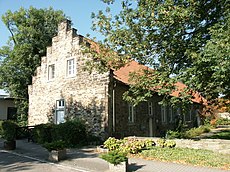
Langendreer is the largest and most populous district of the city of Bochum in the Ruhr area in Germany, with a population of 25,438 as of 31 December 2023. The district is located between the cities Dortmund, the largest city of Westphalia, to the east and Witten to the south, and four other districts of Bochum to the north and west — Langendreer-Alter Bahnhof, Bochum-Laer, Bochum-Querenburg [de], and Bochum-Werne. Langendreer is the easternmost district of Bochum. The district includes, among others, Kaltehardt [de], a mainly residential area, Langendreerholz [de], and Ümmingen [de]. Bochum-Langendreer station is one of the largest railway stations in Bochum and the district is also served by Bochum-Langendreer West station. The freight station in Langendreer was one of the reasons why the village and administrative district of Langendreer was incorporated into the city of Bochum on 1 August 1929, as Bochum did not have comparable capacities. Langendreer used to be one of the main centers of the East Prussian minority in Western Germany.
In the early 20th century coal mining and steel manufacturing were the primary employers in Langendreer.
Langendreer-Alter Bahnhof is a statistical district and monument area of the city of Bochum. Langendreer-Alter Bahnhof is in the east side of the city, between Bochum-Querenburg and Bochum-Werne. It used to be, and to some extent, still is a business district that accommodated the needs of the mines and railway, while the rest of Langendreer is more of a "village" with residential areas.
Langendreer-Alter Bahnhof is south of the main Autobahn of the Ruhr, A 40.
Notable people
- Bastian Pastewka, German actor and comedian
- Paul Nieder-Westermann, Nazi official
- Fritz Katzmann, SS-Gruppenführer and war criminal
References
- ^ Kreuzer, Alfred. "Heimatkundliche Streifzüge durch Langendreer" (in German). Retrieved 15 September 2024.
- ^ Stadt Bochum. "BOStatIS Bochumer Statistisches Informations - System: Einwohner 2023: JB 5 Altersgruppen". duvatools.bochum.de. Retrieved 2024-02-04.
- ^ Stadt Bochum. "BOStatIS Bochumer Statistisches Informations - System: Einwohner 2022: Deutsche / Ausländer Erste Staatsangehörigkeit". duvatools.bochum.de. Retrieved 2023-03-22.
- Reekers, Stephanie (1977). Die Gebietsentwicklung der Kreise und Gemeinden Westfalens 1817–1967 (in German). Aschendorff, Münster Westfalen. p. 255. ISBN 3402058758.
{{cite book}}: CS1 maint: location missing publisher (link) - Bleidick, Dietmar (2021). "Bochum: Industriekultur im Herzen des Reviers" (PDF) (in German). Essen: Regionalverband Ruhr. Retrieved 15 September 2024.
- "Heimatstube Langendreer" (in German). Deutsches Bergbau-Museum Bochum. Retrieved 15 September 2024.
- Clarke, Michael (2020). "Eisen und Stahl" (PDF) (in German). Essen: regionalverband Ruhr. Retrieved 15 September 2024.
- Stadt Bochum. "Die Eröffnung des Opelwerks in Bochum" (in German). Retrieved 15 September 2024.
- Stadt Bochum. "Denkmalbereich Langendreer-Alter Bahnhof" (in German).
- Juskowiak, Nadja (13 January 2015). "Denkmäler der Gründerzeit und Dorfidylle in Langendreer". Westdeutsche Allgemeine Zeitung (in German). Retrieved 15 September 2024.
External links
51°28′25″N 7°19′27″E / 51.47361°N 7.32417°E / 51.47361; 7.32417
This Bochum location article is a stub. You can help Misplaced Pages by expanding it. |